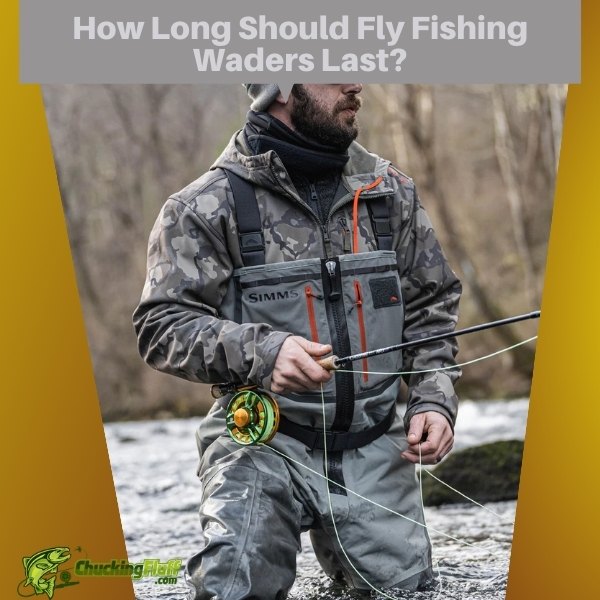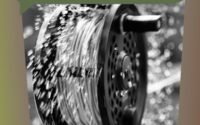| Disclosure: Just to be open and honest the buttons and links you click on in the website will in most cases take you to another website where you can purchase the products I am reviewing. As an Amazon Associate I earn from qualifying purchases. |
How Long Should Fly Fishing Waders Last? Increase Lifespan

There are various types of waders in today’s market but fly fishing ones are cut and made differently to suit their purpose.
Fly fishing waders are a crucial part of an angler’s gear kit and for the investment, we expect faithful service from them.
So, how long should fly fishing waders last?
Quality fly fishing waders should last you an average of 4 to 5 seasons if you are a guide or a fervent angler who is constantly on the water.
However, there is a bunch of factors that will influence the duration your fly-angling waders will last.
These are the material type and quality, the craftsmanship, the frequency of use, care and maintenance, and storage.
If all the above factors are well in place, your gear should serve you a good while before your first repair.
High-grade fly fishing waders are costly and if you are a buyer in this category, you expect more use from them before dumping them.
Quick Post Navigation
How Long Should Fly Fishing Waders Last?
Even though 4 to 5 seasons is the average duration for avid anglers and guides, others can last up to a decade or more, especially if you are an occasional angler or have dozens of pair that you often rotate with each fishing session.
Regardless of the brand you buy, it is vital to read through the warranty and see if the company offers a repair service and the terms attached to the process.
Besides, a return policy is just as important because manufacturing defects happen and there is no better thing for a company to do than to compensate its buyer with a pair in perfect condition.
Let’s learn some factors that will influence how your fly fishing waders last.
Care and Maintenance
How you use your waders will affect their longevity.
The ecstasy level when going fly fishing or testing a new location might make your mind forget to do the basics of wader care when worn.
It is advisable to wear your gear slowly taking care of the zippers, seams, and areas with wear and tear.
You may not be surprised that many anglers pull and haul on their waders in a rush to the stream.
This stresses seams and will in time cause leakage that could well be avoided.
As you walk, ensure you are careful of thorns, thickets, brushes, thistles, and barbed vegetation.
Avoid pushing through patches of shrub; instead, go around them to prevent your waders from getting damaged.
Be very careful when pushing aside thorns and stamping down on bristles and vines because tougher ones can damage to boot foot waders.
Be slow and careful when lacing your boots and securing your gravel guards.
The ankles of Stockingfoot waders have delicate seams connecting the wader materials.
Pulling the gravel guards carelessly pulls the seams apart.
How Frequent You Wear Your Waders
Anglers are a funny lot because even after owning dozens of fly fishing waders, they’ll still stick to two or three at most and leave the rest for once-in-a-while moments.
This tendency for a fervent angler will mean that the three waders will ‘breathe their last’ earlier than the hardly used ones.
Fly fishing wader rotation is ideal for such situations if you don’t want to make purchases frequently.
This practice allows you to use all waders evenly meaning the wear and tear will be even across all waders, so is their aging period.
Granted not every angler can afford to purchase several pairs so proper care is required for the one or couple of pairs you own.
Wader Quality
Wader quality addresses the material and craftsmanship from the cut to the stitching.
The market is now flooded with counterfeit products and poorly made fly fishing waders sold at cheaper prices to win unsuspecting anglers or at prices similar to reputable gear to target fishermen/women who aren’t keen.
The two factors are often compromised by swindlers and novices are usually the target.
You are safer buying waders from a reputable brand because issues of quality and craftsmanship are very few and if any, these are backed by warranties and return policies.
How Long Should Fly Fishing Waders Last? – FAQs
Now that we know how long fly fishing waders last, check out some common questions on the same topic and their straightforward answers.
Q) Does the Fit of Fly Fishing Waders Influence How Long it will Last?
A) Yes, a pair of fly fishing waders that fit properly is expected to last longer than one that doesn’t.
Poor-fitting waders rub or pull on the gear material with the slightest movement and if you know the biggest effect of friction, then wear and tear is to be expected.
Oversize waders can easily be caught by shrubs, thorns, and thickets which is dangerous too.
Q) Should I Throw Waders with a Hole?
A) No. A hole in fly fishing waders doesn’t mean that it has served its time.
Wader repair is common and repaired pairs can last several seasons before leakage occurs in the same area.
Until the waders are overly damaged and repaired beyond handling, you can use them as long as they aren’t leaking.
Q) Do Hip Waders Last Longer than Chest Waders?
A) There isn’t research to justify this yet, thus we consider the approach across all wader designs similar.
4 to 5 seasons for a frequent angler or guide is the estimated duration any pair of fly fishing waders should last.
Wrap U
How long should fly fishing waders last?
Fly fishing waders worn by anglers who fish 4 to 5 times a week will last 4 to 5 seasons if they are made from high-grade material.
Compromises in the quality of the waders will mean their longevity is shorter.
Other factors like how the angler cares and maintains their gear and the frequency of usage matter.
I had a pair of waders last almost ten years before a mouse of all things decided to makes its bed in the stocking foot and ripped it to shreads.
I cut the feet off them and used them as wet-weather outdoor work gear.
Novices who own one pair of fishing waders and are frequently practicing the sport will need to get a backup or replacement pair as soon as possible.
But those with several pairs can rotate their gear to prolong their lifespan.
Even with active usage, wader problems like burst or gaping seams and punctures happen.
This doesn’t mean that they can’t function anymore.
Wader repair is common these days and when done well, repaired wader perform and last long before re-occurrence.
There are different repair methods and products you can purchase to fix your gear for cheap and use them before thinking of a replacement.


